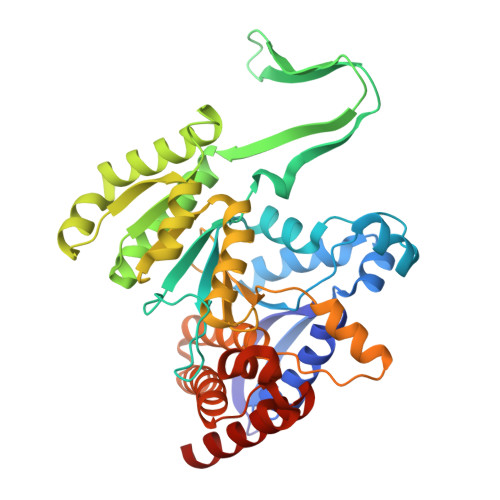Allosteric inhibition of cytosolic NADP + -dependent isocitrate dehydrogenase by oxaloacetate.
Kim, D.K., Cho, H.Y., Cho, H.J., Kang, B.S.(2025) J Struct Biol 217: 108183-108183
- PubMed: 40064325
- DOI: https://doi.org/10.1016/j.jsb.2025.108183
- Primary Citation of Related Structures:
8KIB, 8W49 - PubMed Abstract:
NADP + -dependent cytosolic isocitrate dehydrogenase (IDH1) plays a crucial role in providing reducing energy in response to oxidative stress through the oxidative decarboxylation of isocitrate. NADPH generated by IDH1 serves as an essential cofactor for fatty acid synthesis. The regulation of IDH1 activity is vital for the biological functions of NADPH within cells, and mutations in IDH1 have been implicated in various cancers. In an effort to identify small regulatory molecules for IDH1, we determined the crystal structures of mouse IDH1 complexed with isocitrate and with oxaloacetate. Each IDH1 comprises large and small domains that form an active site, along with a clasp domain that connects two IDH1 molecules for dimerization. Isocitrate was located at the active site in the presence of a magnesium ion, while oxaloacetate was found at a novel site formed by the two clasp domains, in addition to the active site. The activity of IDH1 was diminished in the presence of oxaloacetate and could not be restored by the addition of isocitrate, indicating the presence of allosteric regulation. The activity of the IDH1 H170A mutant, which is unable to bind oxaloacetate in the clasp domain, was unaffected by oxaloacetate. This allosteric regulatory site may serve as a potential target for novel IDH1 inhibitors.
- School of Life Science and Biotechnology, KNU Creative BioResearch Group, Kyungpook National University, Daegu 41566, Republic of Korea.
Organizational Affiliation:



















